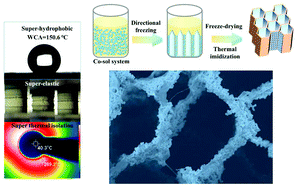Superhydrophobic and elastic silica/polyimide aerogel based on double confinement growth strategy of the co-sol system†
Abstract
Polyimide (PI) aerogels with high thermal stability and low thermal conductivity can be used in the field of high-temperature insulation. However, the superhydrophilicity of the PI aerogel means the structure of the aerogel is easily damaged by water and then the thermal insulation performance is obviously reduced. In addition, the poor elasticity of PI aerogels limits their areas of application where more flexible materials are required. Herein, the authors synthesized a silica/polyimide (SiO2/PI) composite aerogel with both superhydrophobicity and elasticity through the strategy of “double confinement growth”. In this “double confinement” process, a “co-sol” system of silica/polyamic acid salt (SiO2/PAAs) was directionally frozen instead of a traditional “co-gel” system preparation. The freely movable SiO2 and PI were aligned under the confinement of ice crystals to form a regular honeycomb structure. Then it underwent freeze-drying and imidization to form the final SiO2/PI aerogel. Due to the introduction of a large amount of methyl groups, the aerogel has excellent superhydrophobicity, where the water contact angle reaches 153.1°. Water droplets can roll freely on the surface of the aerogel, and this lotus effect can prevent the structure of the aerogel from being damaged by water. Meanwhile, the regular honeycomb structure provides good elasticity for the material. The volume recovery rate reached 99.2% after 80% strain, and the volume recovery rate was 96.22% after 50% strain in 50 cycles. Moreover, the compression does not reduce the thermal conductivity of the material (0.0374 w m−1 K−1). This shows that the synthesized aerogel material can still maintain its high-efficiency heat insulation performance under repeated compression. The unique high thermal decomposition temperature of PI and SiO2 ensures the stability of the aerogel in a high-temperature environment, and at the same time, its non-combustible and non-melting characteristics can effectively prevent the spread of and damage by flames. This novel elastic and superhydrophobic aerogel is an ideal choice for high-temperature insulation materials, especially for flexible insulation materials such as high-temperature insulation cloth.



 Please wait while we load your content...
Please wait while we load your content...